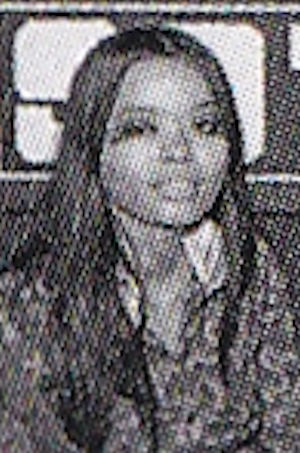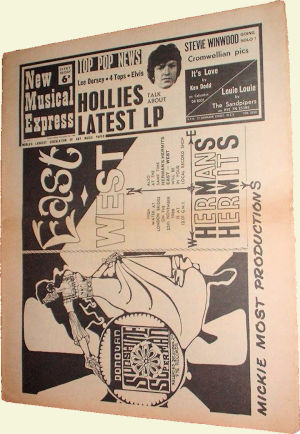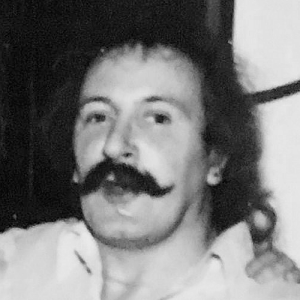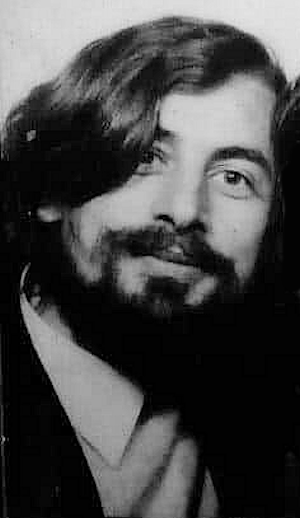Little old lady from London-by-the-Sea

Tranquillity is slowly descending upon the Holy Church of Inuit like smog upon Victorian London. Several brethren and sistren of the Church, and one-time visitors who entered through the front gate to study its baroque interior, have passed some valid information to the Reverend and these will be further investigated in the future. The Reverend also wants to apologise to the people that have been contacted (and interviewed) last year, especially those associated with The Cromwellian club. The articles about The Crom have been postponed due to the unexpected result the Mojo Syd Barrett article created, but they will - one day - hopefully appear.
To all our readers: please keep on going on giving the Church information, how futile it may be, but remember that the Reverend will not break its own rules that stay unchanged even now that Iggy (Evelyn) has been found. Especially now that Iggy (Evelyn) has been found.
The Reverend is not a souvenir collector who will ring at her bell like all those so-called (and in the Reverend's eyes: messed up) true fans used to do at Syd Barrett’s door. Evelyn's wish to be left in peace is and will be unconditionally granted. The same goes for other witnesses of the Barrett era, the Church will send them a nice note from time to time, as a reminder of its presence, but will not break their privacy. Some will call this bad journalism but the Church is not dependent from sold issues and follows a strict deontological code.
Croydon Guardian
On the thirteenth of February of this year The Croydon Guardian published a short, hastily noted down, interview with (a quite reluctant) Iggy, titled: Croydon Guardian tracks down elusive rock star muse. Here it is in full (with some comments from the Reverend):
Croydon Guardian tracks down elusive rock star muse
By Kirsty Whalley
An iconic model who stole Syd Barrett’s heart in the 1960s has been found after three decades of anonymity. Known only as Iggy, the enigmatic woman was immortalised posing naked for the Pink Floyd star’s solo album, Madcap Laughs. She disappeared in the late 1970s and has been living in West Sussex, oblivious to her iconic status. In September 2008, the Croydon Guardian appealed for information about the model and, more than a year later, we managed to track her down.
The story of how the Holy Church of Iggy the Inuit convinced The Croydon Guardian to assign some place in its columns for the Iggy enigma can be found at Where did she go? and (I've got my) Mojo (working...).
She inspired artist Anthony Stern, who filmed her dancing in Battersea Park and also took striking photographs of her on a houseboat in Chelsea. They were released at the City Wakes festival – a tribute to Syd Barrett – in October 2008, in Cambridge.
The above has of course been extendedly covered by the Church as well: Anthony
Stern.
Mr Stern said: “Iggy was my muse. I met her at a Hendrix gig at the Speakeasy. She entirely captures the spirit of the Sixties, living for the moment, carefree.”
Jimi Hendrix gigged quite a few times at The Speakeasy and was spotted there on other occasions as well, for instance on the 22nd of February when he attended a press conference for The Soft Machine.
Jimi Hendrix
The club has been described in the (excellent) London Live book from Tony Bacon as follows (most information about the club has been taken from that book).
When The Speakeasy was opened by Roy Flynn around the end of 1966 in Margaret Street, just north of Soho, the rock elite soon discovered a handy new watering hole, a prime early-hours jamming post, and an altogether useful hanging-out kind of place.
By May 1967 the club was part of the London spot-the-celebrity circle next to - amongst others - the Scotch (of St. James) and of course the Crom. On a good night you could having a drink next to The Bee Gees, Jeff Beck or The Who, although, keeping up his avant-garde experimental jazz appearance, Robert Wyatt from The Soft Machine couldn't care less: "Rock groups meeting in expensive clubs that are difficult to get into? What's all that crap?"
On the 19th of January 1967 Jimi Hendrix gave the first of 3 concerts at The Speak. On top of that he would also jam a few times with other people on stage, including Jose Feliciano and Georgie Fame. That night in January he tried to get into Marianne Faithfull's pants with the seductive remark: "What are you doing with this jerk, anyway?" The jerk in question was of course Mick Jagger who wanted to check out the new kid in town.
Yes-fans will know the club for its owner Roy Flynn. When, on the 13th of December 1968, Sly And The Family Stone didn't show up for their gig an impromptu band was found to take their place. When Roy Flynn saw Yes's performance he was so thrilled that he became their manager for a while. The band eagerly agreed, not because he had some managerial skills but because the restaurant at The Speak had an excellent reputation:
Roy had never managed a band before and he kind of took us on and then the whole world of the Speakeasy opened up (laugh). It was a great club, I mean, it was a wonderful club, it used to close at 4 AM and we would not only rehearse there, we would play there some nights, and of course after a gig if we were playing within, let's say 150 miles from London, we would rush and go to the Speakeasy and eat there, and most of the meals were completely free. So for about a year I ate pretty good. Most of the evenings I ate there. Because that was the life style, we would be in the Speakeasy after 3 AM and the kitchen still would be opened and the food was not fantastic but thanks to Roy Flynn we would get free food and quite a lot of few drinks as well. (Peter Banks, who invented the band's name and left the group in 1970)
The extensive Jimi Hendrix gig database
located at Rich Dickinson only mentions 3 genuine Jimi Hendrix
performances in 1967: the aforementioned gig on the 19th of January 1967
and two more in March: 8th March 1967 and 21st March 1967. So Iggy (and
Anthony Stern) must have attended one of these. For the completists
amongst us the Church gives now the complete list of Hendrix sightings
at the Speakeasy (1967):
67-01-19: Gig.
67-02-22: Press
reception for the Soft Machine.
67-03-08: Gig.
67-03-16:
Launching party for Track records (Jimi gives three interviews).
67-03-21:
Gig.
67-04-17: Jam (on bass) with Georgie Fame (on organ) and
Ben E. King (drums).
67-05-08: Brian Auger Trinity Concert.
67-06-04:
Jose Feliciano concert and onstage jam.
67-12-06: Party for The
Foundations.
67-12-22: Musicians from Christmas on Earth and Hendrix
jam until the morning hours.
67-12-31: New Year's Eve Party where
Jimi plays a thirty minute 'Auld Lang Syne'.
London Live
There is quite an intriguing picture
on page 103 of the London Live book, showing co-managers Roy Flynn and
Mike Carey, sitting at the Speakeasy bar, accompanied by two ladies.
According to CowleyMod
one of the women undoubtedly is Ig. Although most of the members of the
Church do not think it is her the Church wants to give Cowleymod the
benefit of the doubt and the visitors of the Church the chance to make
up their own mind (click here
to see the full picture).
Update (November 2010): it has been
confirmed to the Church that the person on the picture is NOT Iggy /
Evelyn.
Iggy said: “I cannot believe there is a film of me, that there are photos of me.”
Iggy spent a brief part of the 60s living in Croydon with DJ Jeff Dexter, who used to play at the Orchid Ballroom. She said: “The Orchid Ballroom was the place to be, the atmosphere was fantastic. I loved going there, I loved to dance. Jeff wanted to turn me and two other lovely girls into the English version of the Supremes, but that never happened.”
She does not like to talk much about Syd Barrett, but admits she lived with him in Chelsea in the late 1960s. She said: “Syd was so beautiful looking. We had a relationship, I lived with him for a while.”
Although the Reverend is aware of at least four witnesses who have confirmed in different biographies (and directly to the Church) that Iggy and Syd weren't an item this is now contradicted by Evelyn herself.
It was at that time she became known as Iggy the Eskimo. She said: “In part I made up the nickname. The rest was the photographer Mick Rock, who asked where I was from. I said ‘my mother is from the Himalayas’ and he said ‘we will call you Iggy the Eskimo’.”

The Church will not deny that Mick Rock may have thrown around the 'Iggy the Eskimo' nickname to describe the mysterious girl on his pictures but the epithet dates from much earlier. It was first spotted in the NME magazine from the 25th of November 1966 (more than 2 years earlier) where Evelyn was described as 'Another Bender - model IGGY, who is half-Eskimo': Bend It!
Mick Rock took the pictures for Madcap Laughs. Iggy said: “When Mick turned up to take the photos I helped paint the floor boards for the shoot, I was covered in paint, I still remember the smell of it. In the pictures my hair looks quite funny, I remember hiding my face behind it because I did not want my mum and dad to see it."
Again other witnesses tell other stories. They claim that Syd (with a little help from Iggy) painted the floor boards early in the year, certainly before April 1969. As Syd only started recording mid-April it is a bit weird that he painted the boards especially for the album cover, unless - of course - he (and with him Mick Rock) already had the cover in mind before the recording sessions started. A theory that is not implausible.
She broke up with Syd Barrett shortly after the photo shoot and moved to Brighton. She said: “I have just been living very quietly, I left London in the 70s and I got married in 1978. I met so many people in the 60s – the Beatles, the Who, the Rolling Stones and Rod Stewart. I was a free spirit. I have left that life behind me now.”
The Church would gladly accept to publish her memoires though. But until that happens, my dear sistren and brethren, don't do anything that Iggy wouldn't have done…
A new gallery has been uploaded containing the complete Come with NME for a pic-visit to THE CROMWELLIAN article and pictures from New Musical Express 1037, 25 November 1966. Photographs by Napier Russel & Barry Peake. Words by Norrie Drummond. (Just another world exclusive from the Holy Church of Iggy the Inuit.)
Sources (other than the above internet links):
Bacon, Tony: London
Live, Balafon Books, London, 1999, p. 101-104.




